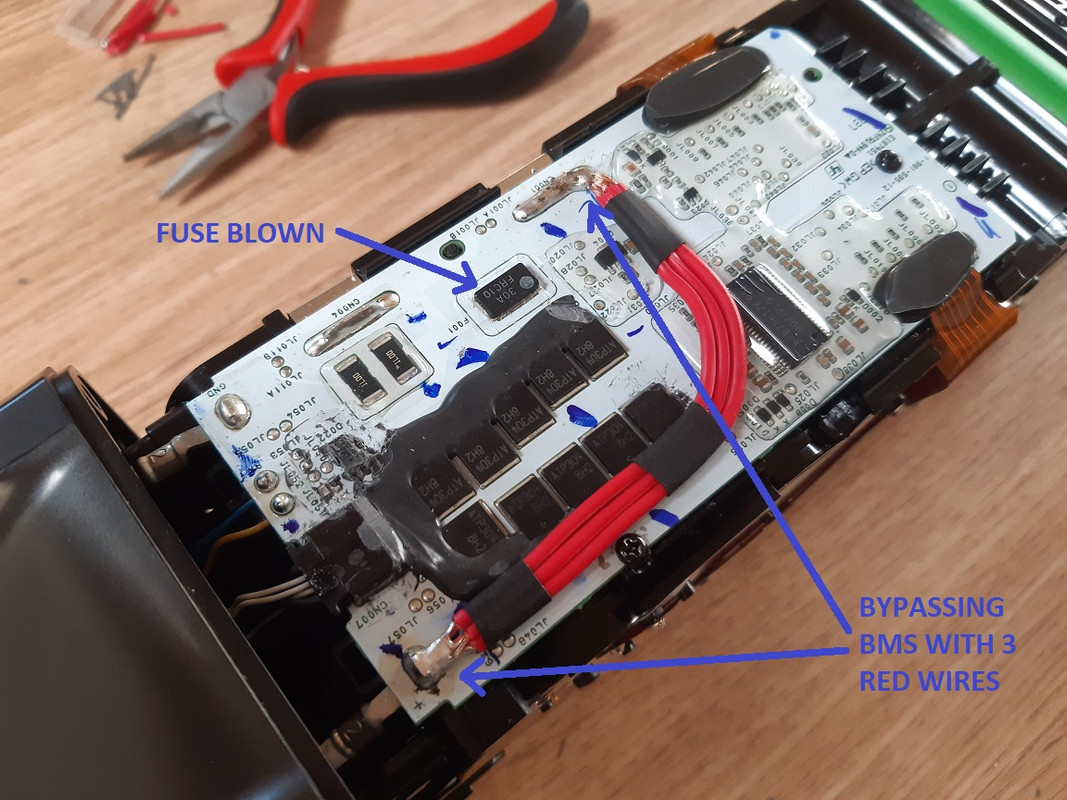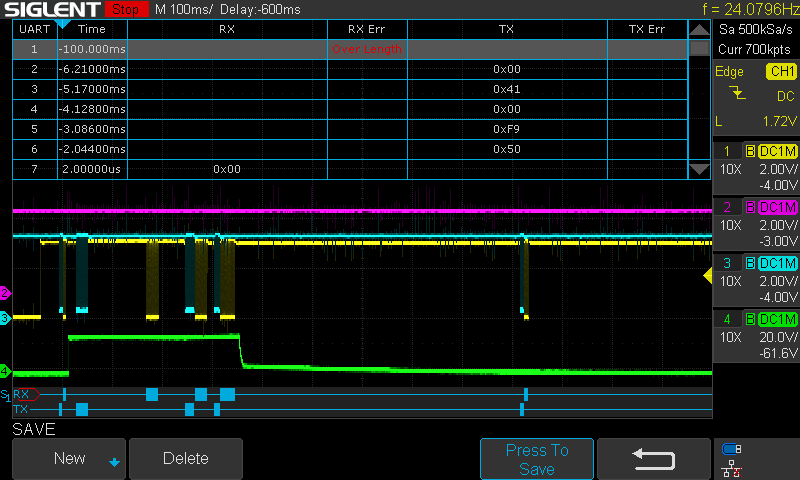So in regards of my previous post i will make a seperate topic about this.
In short, yesterday one of my 2 batteries died. I had just been fully charged the day before, and when i was on the trails riding, i wanted to swap in this battery. But sadly it wouldnt turn on at all. No lights, no error code.
So back home i put it on the charger and the charger now starts blinking, meaning an error. My other battery still works fine in my bike and with that charger. So im left with one dead battery.
Opening it up and measuring voltages etc, shows the cells are all at fully charged state (as expected), the on/off button functions correctly (i can see the signal propagating to the BMS) and the temperature sensors are working fine (i can see them being polled on my scope a couple of times per second).
So i measured a fuse that is surface mounted on the BMS. Its a FR-9550-30A:
https://media.digikey.com/pdf/Data Sheets/Cyntec/FR-9550-30A-(C01~C14)-B_Ds.pdf
(i kinda thougt it was an oscillator before, it looks like a typical SMD oscillator...)
The fuse is located in the path between the cells positive tab and the P-channel high side switches (which regulate power flow in and out of the battery)
So that fuse seems to be blown, or at least not showing full conductance. Now the weird part is, that fuse has an integrated heating element inside. Possibly to blow the fuse deliberately by the BMS itself. So now the question arises, did that fuse just accidently blew, or did the BMS blew the fuse deliberately? Im measuring some weird voltage fluctuations coming out of the fuse's primary contacts, but also the heater pin. Could the BMS be in a state actively trying to destroy the fuse?
Anyway, im now set out to just bypass the BMS and see if i can still keep using this battery. I know, i know, not the safest thing to do, but im still on the road for a couple of months so i see this more as a temporary fix, an experiment. I dont recommend other people just doing this, but perhaps we can learn a thing or 2 here...
So my bypass:

I just figured i would permanently bypass both the Fuse and the high side P-channel mosfet switches.
And lo and behold, it works!
Well im still in the testing phase. But what i can tell is that the bike has no problem with this battery. Obviously you no longer have an on/off switch so as soon as you insert the battery it turns the bike on. However i get no error codes, and battery percentage is reported correctly (at least initially at 100%). I get motor power when i start pedaling, just like normal.
STunlocker shows correct battery percentage and usage as well (current battery health at 89%, 93cycles). So i will do some more real world testing later this day, see if it keeps working ok!
Now, i still need to figure out the charging. Since the charger does not agree with the BMS it will still not charge the battery. Perhaps i will try to find one of those generic amazon ebike 36V 10cell ebike chargers and just connect to the battery terminals. At least i think i can ship one to a local amazon locker in the area...
In short, yesterday one of my 2 batteries died. I had just been fully charged the day before, and when i was on the trails riding, i wanted to swap in this battery. But sadly it wouldnt turn on at all. No lights, no error code.
So back home i put it on the charger and the charger now starts blinking, meaning an error. My other battery still works fine in my bike and with that charger. So im left with one dead battery.
Opening it up and measuring voltages etc, shows the cells are all at fully charged state (as expected), the on/off button functions correctly (i can see the signal propagating to the BMS) and the temperature sensors are working fine (i can see them being polled on my scope a couple of times per second).
So i measured a fuse that is surface mounted on the BMS. Its a FR-9550-30A:
https://media.digikey.com/pdf/Data Sheets/Cyntec/FR-9550-30A-(C01~C14)-B_Ds.pdf
(i kinda thougt it was an oscillator before, it looks like a typical SMD oscillator...)
The fuse is located in the path between the cells positive tab and the P-channel high side switches (which regulate power flow in and out of the battery)
So that fuse seems to be blown, or at least not showing full conductance. Now the weird part is, that fuse has an integrated heating element inside. Possibly to blow the fuse deliberately by the BMS itself. So now the question arises, did that fuse just accidently blew, or did the BMS blew the fuse deliberately? Im measuring some weird voltage fluctuations coming out of the fuse's primary contacts, but also the heater pin. Could the BMS be in a state actively trying to destroy the fuse?
Anyway, im now set out to just bypass the BMS and see if i can still keep using this battery. I know, i know, not the safest thing to do, but im still on the road for a couple of months so i see this more as a temporary fix, an experiment. I dont recommend other people just doing this, but perhaps we can learn a thing or 2 here...
So my bypass:

I just figured i would permanently bypass both the Fuse and the high side P-channel mosfet switches.
And lo and behold, it works!
Well im still in the testing phase. But what i can tell is that the bike has no problem with this battery. Obviously you no longer have an on/off switch so as soon as you insert the battery it turns the bike on. However i get no error codes, and battery percentage is reported correctly (at least initially at 100%). I get motor power when i start pedaling, just like normal.
STunlocker shows correct battery percentage and usage as well (current battery health at 89%, 93cycles). So i will do some more real world testing later this day, see if it keeps working ok!
Now, i still need to figure out the charging. Since the charger does not agree with the BMS it will still not charge the battery. Perhaps i will try to find one of those generic amazon ebike 36V 10cell ebike chargers and just connect to the battery terminals. At least i think i can ship one to a local amazon locker in the area...



